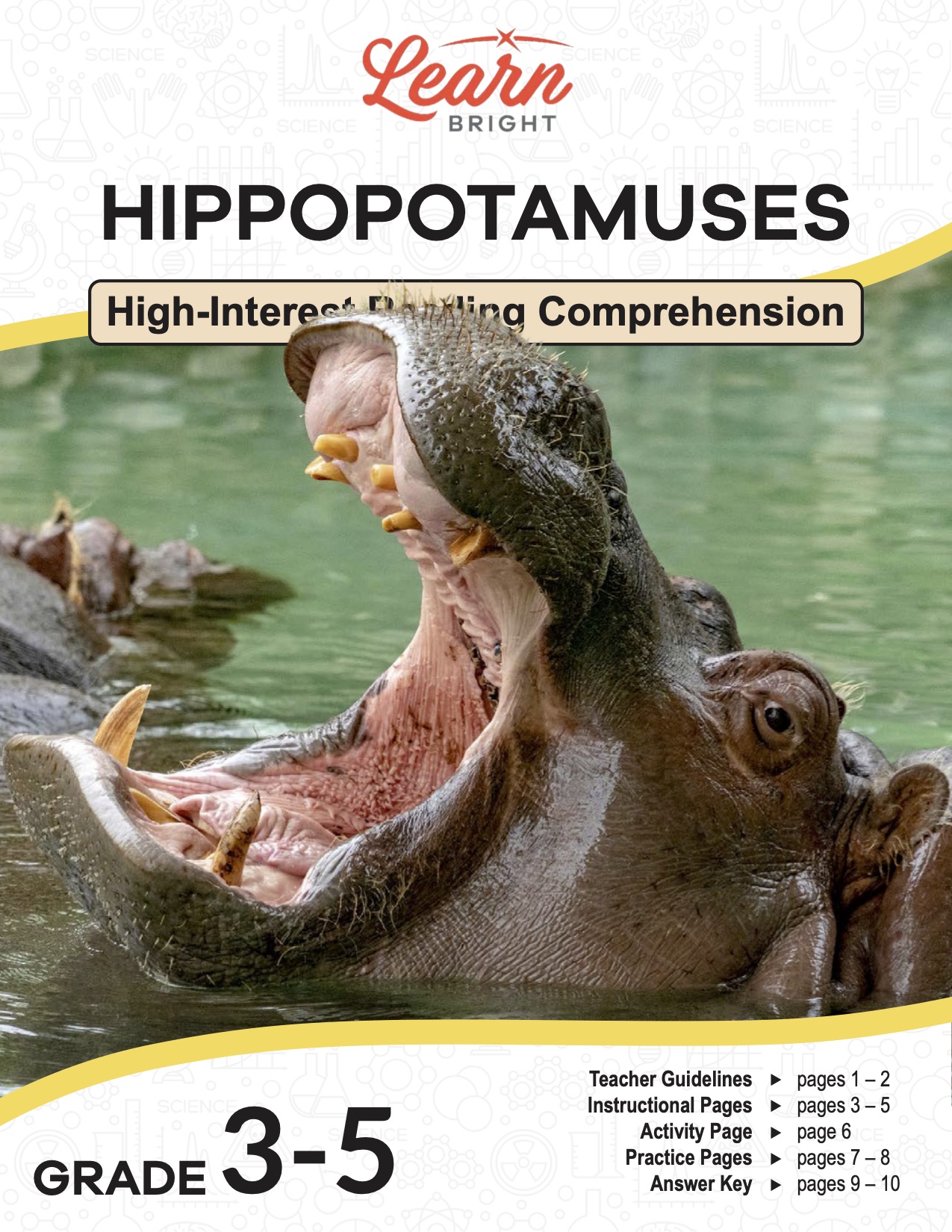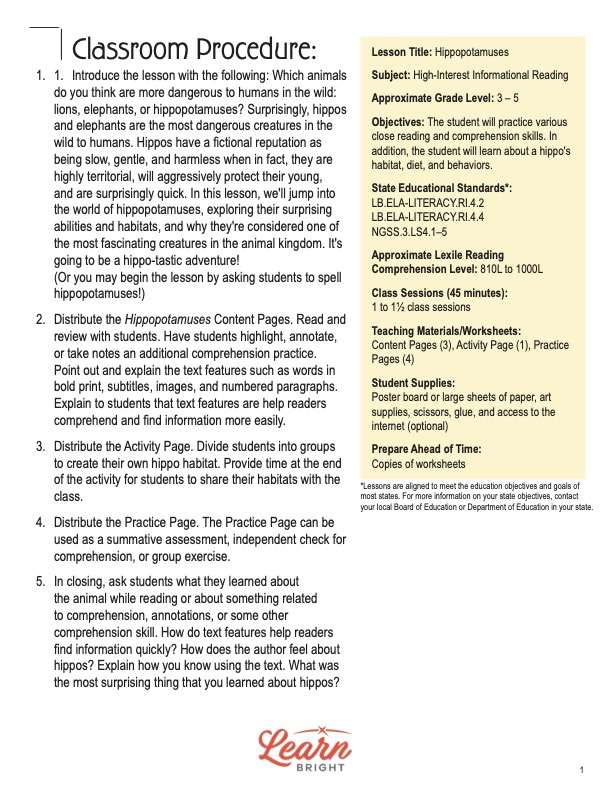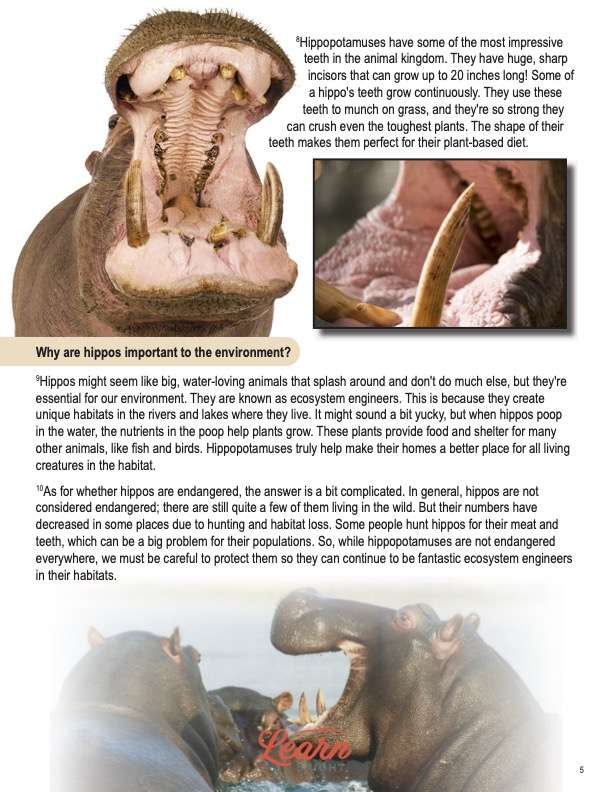Description
What our Hippopotamuses lesson plan includes
Lesson Objectives and Overview: Hippopotamuses is a high-interest reading comprehension lesson plan. As such, students will practice various close reading and comprehension skills. In addition, they will learn about hippos’ habitat, diet, and behaviors. This lesson is for students in 3rd grade, 4th grade, and 5th grade.
Classroom Procedure
Every lesson plan provides you with a classroom procedure page that outlines a step-by-step guide to follow. You do not have to follow the guide exactly. The guide helps you organize the lesson and details when to hand out worksheets. It also lists information in the yellow box that you might find useful. You will find the lesson objectives, state standards, and number of class sessions the lesson should take to complete in this area. In addition, it describes the supplies you will need as well as what and how you need to prepare beforehand.
Teacher Notes
The paragraph on this page provides a little more information or guidance on what to expect from the lesson. It explains that you can teach this lesson in a whole-class setting or as an independent, small-group activity. You can use the blank lines to record any thoughts or ideas you have as you prepare.
HIPPOPOTAMUSES LESSON PLAN CONTENT PAGES
What Is a Hippopotamus?
The Hippopotamuses lesson plan contains three content pages. It begins by providing a box of background information about this animal. A hippo is a mammal that lives in sub-Saharan Africa. Hippos generally eat short grasses and fruit. They can live for up to 50 years.
Hippopotamuses (hippos for short) are big, round animals with short legs and huge mouths. They have thick, tough skin that helps protect them from the sun and other animals. Their skin can look pink or gray, and they spend lots of time in the water to keep cool. Hippos also have big, sharp teeth that they use to munch on plants. Hippos weigh up to 3,000 pounds, the same weight as a small car. And even though they are big, they can run surprisingly fast!
Hippos like to live in groups called pods. These pods can have anywhere from a few hippos to over 100! Living in a group helps them stay safe from predators like lions and crocodiles. They can hold their breath for a long time, so they spend a lot of time in the water. Hippos are also known for being noisy animals. They make loud grunts and roars to communicate with each other.
When it comes to caring for their young, hippopotamuses are good parents. Male hippos are called bulls, and females are called cows. Baby hippos, called calves, stay close to their moms and can even drink their mom’s milk underwater. Hippos are known for being very protective of their young and will do whatever it takes to keep them safe from harm. Sometimes, they even let the calves ride on their backs in the water!
Diet of a Hippo
Hippos are primarily herbivores, which means they eat plants. Their favorite food is grass! They have big mouths and sharp teeth that help them munch on the tasty grasses they find near rivers and lakes. Hippos are like lawnmowers because of how they cut, chop, and eat grass with their teeth. In fact, they eat about 80 pounds every day! They need to eat so much because they’re big animals, and all that grass gives them the energy they need to stay strong and healthy.
Hippopotamuses graze, meaning they walk around and eat the plants they find. Remember that they spend a lot of time in the water to stay cool? Well, while in the water, they don’t catch prey like fish. They mostly stick to their vegetarian diet and sometimes munch on water plants.
Interesting Facts
The skin of a hippopotamus produces something called hipposudoric acid, which acts like a natural sunscreen and keeps their skin safe from the hot sun. Plus, this acid can make their skin look red, orange, or pink instead of gray, which is pretty cool! Their skin secretes a moisturizer as well, which also helps protect the skin and keep it moist. Despite their size, hippos have very little body fat. Less than 20% of their weight comprises skin and a thin layer of fat. This is comparable to a human professional athlete! The rest of a hippo’s size comes from their bones and muscles.
Adult hippos can hold their breath for up to five minutes. They close their nostrils using a flap of skin to keep water out when they dive under. Hippos can sleep under water, too! They have a reflex that makes them bob to the surface, take a breath, and sink back down without waking up. And although hippos spend so much time in the water, they can’t swim or float in the traditional sense. They’re so big and heavy that they walk or run along the bottom. In fact, they tiptoe and gently bounce up to the water’s surface. It gives the impression that they are gliding across the water like a water ballet dancer.
Hippopotamuses have some of the most impressive teeth in the animal kingdom. They have huge, sharp incisors that can grow up to 20 inches long! Some of a hippo’s teeth grow continuously. They use these teeth to munch on grass, and they’re so strong they can crush even the toughest plants. The shape of their teeth makes them perfect for their plant-based diet.
Why Are Hippopotamuses Important?
Hippos might seem like big, water-loving animals that splash around and don’t do much else, but they’re essential for our environment. They are known as ecosystem engineers. This is because they create unique habitats in the rivers and lakes where they live. It might sound a bit yucky, but when hippos poop in the water, the nutrients in the poop help plants grow. These plants provide food and shelter for many other animals, like fish and birds. Hippopotamuses truly help make their homes a better place for all living creatures in the habitat.
As for whether hippos are endangered, the answer is a bit complicated. In general, hippos are not considered endangered; there are still quite a few of them living in the wild. But their numbers have decreased in some places due to hunting and habitat loss. Some people hunt hippos for their meat and teeth, which can be a big problem for their populations. So, while hippopotamuses are not endangered everywhere, we must be careful to protect them so they can continue to be fantastic ecosystem engineers in their habitats.
HIPPOPOTAMUSES LESSON PLAN WORKSHEETS
The Hippopotamuses lesson plan includes two worksheets: an activity worksheet and a practice worksheet. Each one will help students solidify their grasp of the material they learned throughout the lesson. You can refer to the classroom procedure guidelines to know when to hand out each worksheet.
HIPPO HABITAT ACTIVITY WORKSHEET
For the lesson activity, students will get to pretend they are animal experts hired to design a habitat for hippos at a zoo! After they read the intro paragraph at the top of the page, they will follow the directions to design a habitat that two new hippopotamuses will enjoy at the local zoo. The space at the bottom of the page is for a rough draft. Students’ final drafts should be on a larger poster board or chart paper.
HIPPOPOTAMUSES PRACTICE WORKSHEET
The practice worksheet lists 11 questions based on the content. These questions all relate to the content pages, so students will need to refer to them often for the answers. In addition, each question provides which reading tool the question corresponds to, such as text feature, vocabulary, or comprehension.
Worksheet Answer Keys
At the end of the lesson plan document is an answer key for the practice worksheet. The correct answers are all in red to make it easier for you to compare them with students’ responses. If you choose to administer the lesson pages to your students via PDF, you will need to save a new file that omits these pages. Otherwise, you can simply print out the applicable pages and keep these as reference for yourself when grading assignments.










